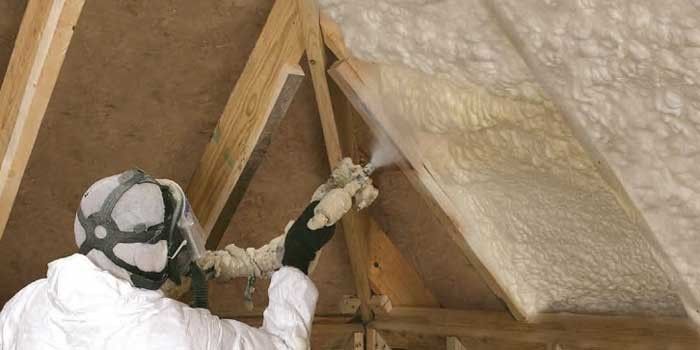Revitalizing Old Buildings with Spray Foam Insulation
Spray Foam Insulation in Historic Renovations in Spresser

Spresser, with its rich history and architectural heritage, boasts a collection of historic buildings that tell the story of bygone eras. Preserving and revitalizing these structures is not only a matter of cultural significance but also a practical necessity for maintaining the integrity of the community. As the demand for sustainable and energy-efficient solutions grows, historic renovations in Spresser are undergoing a transformation, with spray foam insulation emerging as a key player in the preservation and enhancement of these treasures. In this comprehensive guide, we will explore the unique challenges of revitalizing old buildings, the benefits of spray foam insulation, and how this innovative solution is contributing to the restoration of Spresser's historic charm.
Challenges of Revitalizing Old Buildings
Historic renovations present a set of challenges distinct from those faced in modern construction. Preserving the architectural authenticity while incorporating modern amenities and improving energy efficiency requires a delicate balance. Here are some challenges commonly encountered in revitalizing old buildings:
1. Energy Inefficiency: Historic buildings often lack the insulation standards of modern constructions, leading to increased energy consumption and higher utility bills.
2. Structural Integrity: Over time, the structural components of historic buildings may deteriorate, requiring careful assessment and reinforcement.
3. Moisture Management: Older structures may face issues with moisture infiltration, leading to mold growth, rot, and other structural concerns.
4. Historic Preservation Regulations: Renovation projects involving historic buildings must adhere to specific preservation guidelines and regulations to maintain the authenticity of the structure.
5. Customization for Modern Use: Adapting historic buildings for contemporary use without compromising their historical significance can be a complex task.
Spray Foam Insulation as a Solution
Spray foam insulation has emerged as a versatile and effective solution for addressing many of the challenges associated with historic renovations. Its unique properties make it an ideal choice for revitalizing old buildings in Spresser and other communities with rich architectural histories.
1. Adaptability to Irregular Spaces: One of the key advantages of spray foam insulation is its ability to conform to irregular and hard-to-reach spaces. This is particularly valuable in historic buildings with unconventional layouts and architectural features.
2. Air Sealing and Energy Efficiency: Spray foam insulation acts as a powerful air barrier, sealing gaps and cracks in the building envelope. This not only enhances energy efficiency by preventing air leaks but also contributes to a more comfortable indoor environment.
3. Minimal Intrusiveness: Unlike traditional insulation materials, spray foam insulation can be applied with minimal disruption to the existing structure. This is especially important in historic renovations where preserving the building's original features is a top priority.
4. Moisture Management: Closed-cell spray foam, in particular, serves as an effective moisture barrier, preventing water vapor from infiltrating the building envelope. This can help mitigate issues related to mold, rot, and structural decay.
5. Strengthening Structural Integrity: Spray foam insulation, when applied, adheres to surfaces and can provide additional structural support. This can be beneficial in reinforcing aging structures and enhancing overall stability.
Benefits of Spray Foam Insulation in Historic Renovations
1. Preservation of Architectural Details: The adaptability of spray foam insulation allows for precise application, ensuring that intricate architectural details are preserved. This is crucial for maintaining the historical authenticity of the building.
2. Energy Efficiency without Sacrificing Aesthetics: Unlike some traditional insulation methods, spray foam insulation doesn't require sacrificing the aesthetic appeal of historic buildings. It can be seamlessly integrated into walls, ceilings, and floors without compromising visual elements.
3. Improved Indoor Comfort: By creating a continuous and airtight seal, spray foam insulation contributes to consistent indoor temperatures, enhancing the comfort of occupants. This is particularly important in historic buildings where maintaining a comfortable environment is essential for preservation.
4. Long-Term Cost Savings: While the initial cost of spray foam insulation may be higher than some traditional methods, the long-term cost savings through increased energy efficiency often outweigh the upfront investment. This can be a crucial factor for building owners looking to manage operating costs over time.
Considerations for Spresser's Historic Renovations
Preservation Guidelines: Before undertaking any historic renovation project, it's essential to familiarize yourself with local preservation guidelines and regulations. Work closely with preservation boards and professionals who understand the specific requirements for maintaining the historical authenticity of the building.
Custom Solutions: Each historic building is unique, and custom solutions may be necessary to address specific challenges. Consult with experienced contractors and architects who specialize in historic renovations and have expertise in integrating innovative insulation solutions.
Material Compatibility: When working with historic structures, it's crucial to consider the compatibility of insulation materials with existing building materials. Spray foam insulation's versatility and adaptability make it a suitable choice for various surfaces.
Budgetary Considerations: While spray foam insulation offers long-term cost savings, it's important to consider the upfront investment. Work with professionals to assess the overall cost-benefit analysis and explore available funding or incentive programs for historic preservation projects.
Collaboration with Preservationists: Foster collaboration between insulation experts and preservationists to ensure a holistic approach to the renovation. By combining the expertise of both fields, you can achieve a balance between energy efficiency and historical preservation.
Revitalizing old buildings in Spresser through historic renovations is a commendable endeavor that contributes to the city's cultural richness and architectural legacy. Spray foam insulation, with its innovative properties and adaptability, has proven to be a valuable asset in overcoming the challenges associated with preserving historic structures.
As Spresser continues to evolve, the integration of spray foam insulation in historic renovations not only enhances energy efficiency and indoor comfort but also ensures that the city's heritage remains vibrant for generations to come. By carefully considering the unique requirements of each historic building and collaborating with professionals well-versed in both preservation and innovative insulation solutions, Spresser can successfully balance tradition with modernity, creating a harmonious blend of the past and the future in its architectural landscape.
SPEAK TO A TEAM MEMBER TODAY

All Rights Reserved | Spresser Spray Foam Insulation
Website Managed by
Leads By Vinny